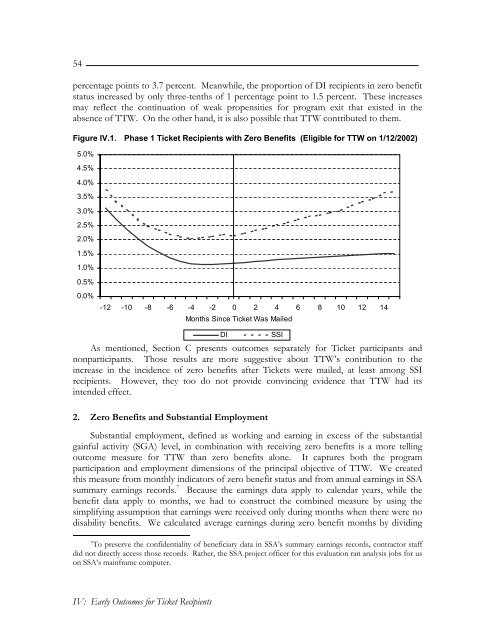Evaluation of the Ticket to Work Program, Implementation ...
Evaluation of the Ticket to Work Program, Implementation ...
Evaluation of the Ticket to Work Program, Implementation ...
Create successful ePaper yourself
Turn your PDF publications into a flip-book with our unique Google optimized e-Paper software.
54percentage points <strong>to</strong> 3.7 percent. Meanwhile, <strong>the</strong> proportion <strong>of</strong> DI recipients in zero benefitstatus increased by only three-tenths <strong>of</strong> 1 percentage point <strong>to</strong> 1.5 percent. These increasesmay reflect <strong>the</strong> continuation <strong>of</strong> weak propensities for program exit that existed in <strong>the</strong>absence <strong>of</strong> TTW. On <strong>the</strong> o<strong>the</strong>r hand, it is also possible that TTW contributed <strong>to</strong> <strong>the</strong>m.Figure IV.1. Phase 1 <strong>Ticket</strong> Recipients with Zero Benefits (Eligible for TTW on 1/12/2002)5.0%4.5%4.0%3.5%3.0%2.5%2.0%1.5%1.0%0.5%0.0%-12 -10 -8 -6 -4 -2 0 2 4 6 8 10 12 14Months Since <strong>Ticket</strong> Was MailedDIAs mentioned, Section C presents outcomes separately for <strong>Ticket</strong> participants andnonparticipants. Those results are more suggestive about TTW’s contribution <strong>to</strong> <strong>the</strong>increase in <strong>the</strong> incidence <strong>of</strong> zero benefits after <strong>Ticket</strong>s were mailed, at least among SSIrecipients. However, <strong>the</strong>y <strong>to</strong>o do not provide convincing evidence that TTW had itsintended effect.2. Zero Benefits and Substantial EmploymentSubstantial employment, defined as working and earning in excess <strong>of</strong> <strong>the</strong> substantialgainful activity (SGA) level, in combination with receiving zero benefits is a more tellingoutcome measure for TTW than zero benefits alone. It captures both <strong>the</strong> programparticipation and employment dimensions <strong>of</strong> <strong>the</strong> principal objective <strong>of</strong> TTW. We createdthis measure from monthly indica<strong>to</strong>rs <strong>of</strong> zero benefit status and from annual earnings in SSAsummary earnings records. 7 Because <strong>the</strong> earnings data apply <strong>to</strong> calendar years, while <strong>the</strong>benefit data apply <strong>to</strong> months, we had <strong>to</strong> construct <strong>the</strong> combined measure by using <strong>the</strong>simplifying assumption that earnings were received only during months when <strong>the</strong>re were nodisability benefits. We calculated average earnings during zero benefit months by dividing7 To preserve <strong>the</strong> confidentiality <strong>of</strong> beneficiary data in SSA’s summary earnings records, contrac<strong>to</strong>r staffdid not directly access those records. Ra<strong>the</strong>r, <strong>the</strong> SSA project <strong>of</strong>ficer for this evaluation ran analysis jobs for uson SSA’s mainframe computer.SSIIV: Early Outcomes for <strong>Ticket</strong> Recipients
















